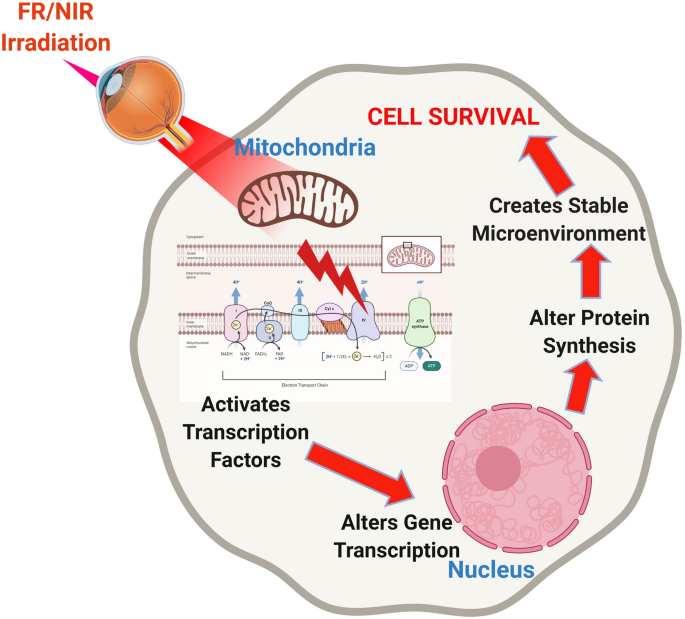4 Simple Techniques For Photobiomodulation
Wiki Article
All about Photobiomodulation
Table of ContentsWhat Does Photobiomodulation Do?The Best Strategy To Use For PhotobiomodulationGetting The Photobiomodulation To WorkThe Best Guide To Photobiomodulation
Laser therapy is a clinical therapy that utilizes concentrated light to stimulate a process called. During PBM, photons get in the tissue and connect with the cytochrome c complicated within mitochondria. This communication sets off an organic cascade of events that causes an increase in mobile metabolism, which can along with accelerate the recovery procedure.There is agreement that the application of a therapeutic dosage of light to damaged or dysfunctional cells leads to a cellular action moderated by mitochondrial mechanisms. Photobiomodulation. Research studies have actually shown that these modifications can influence discomfort and inflammation, in addition to, cells fixing
Modifications in ATP, responsive oxygen varieties and nitric oxide follow light absorption by Cc, O. These impacts are redox state and dosage reliant. In hypoxic or otherwise worried cells it has been shown lot of times that adhering to, nitric oxide is launched, ATP is increased and oxidative tension is minimized [27-31]

All About Photobiomodulation
PBM devices have actually been removed for marketing by FDA with the Premarket Notification/510( k) process as adjunctive tools for the momentary relief of discomfort. These clearances were based on the discussion of clinical information to support such insurance claims (Photobiomodulation). In this therapy, a light is placed near or in call with the skin, allowing the light power (photons) to penetrate tissue where it connects with chromophores found in cells causing photophysical and photochemical modifications that bring about modifications at the molecular, mobile and tissue degrees of the bodySurprisingly, recent study indicates that light can improve efficiency in normal tissues and cells. The prospective applications of PBMT are numerous and are being checked out experimentally at the standard science, pre-clinical and professional degree. The existing medical usages are for the relief of pain and inflammation and the therapy of sporting activities injuries.

The treatment criteria and variety of sessions required for PBMT depend on place and cause. PBMT typically requires greater than one therapy for ideal pain relief. It might take a number of treatments for the results to become noticeable. records that it can take anywhere from 8 to 30 sessions for a treatment to be fully reliable, and some people discover it required to undergo therapy two to four times weekly.
The 25-Second Trick For Photobiomodulation
Therapy criteria for PBMT were originally established utilizing cells artificial insemination and in tiny animal designs. These therapy specifications normally had a reduced irradiance and fluence and functioned well for cutaneous applications. However when clinicians started to make use of PBMT to deal with structures that were located deeper in the body, they utilized these specifications with adverse outcomes.
We now comprehend that these unfavorable research studies resulted from wrong tool and treatment criteria for transcutaneous treatment of much deeper structures. Current advancements in laser therapy devices and more research into the appropriate dosages have actually significantly enhanced the results of PBMT. For treating deep cells, the wavelength of light made use of determines the deepness of infiltration into a tissue.
It is essential that a clinician uses the ideal wavelength you can try these out of light and criteria to deal with a condition. One wavelength and one collection of therapy specifications will not work for all problems. Unfavorable side effects have actually not been reported from using PBMT (Photobiomodulation). Updated June 27, 2016Juanita j
Light therapy is a non-invasive treatment that functions by raising the capability of the cell to create power (ATP) to recover the area being dealt with. As a result, it can decrease swelling, swelling, and pain in the location. Research study in this field is increasing, with more in-depth study papers connected below for those that would such as to find out more.
The Basic Principles Of Photobiomodulation
In the very first experiment, Dr. Endre Mester, made use of cut rats and observing how the laser impacted their capacity to expand hair compared to the group that was not getting LLLT. He located that the team of mice getting LLLT had our website the ability to expand their hair back faster than the team of computer mice that really did not obtain LLLT (Hoon C, et al; 2012).This therapy is called in this manner to differentiate the difference between the lasers some occupations make use of to reduce (eg. in surgical treatments, or dental treatments). Low-level light treatment is painless, non-invasive therapy. It is used to reduce inflammation, swelling, and persistent joint conditions, lower discomfort and increase injury recovery of nerves and cells (Hoon C, et al; 2012).
LLLT has a biphasic action, suggesting that reduced dosages are normally seen to be much more helpful than greater dosages. That being stated, doses higher or less than the optimum dosage does not impact (Hoon C, et al; 2012). Consequently, it can be difficult to have researches on LLLT with many criteria.
check here Some business integrated both (LED and laser) to provide an extra well-shaped therapy because lasers can penetrate deeper than LED and infrared light (Norman Doidge, The Brain's Way of Recovery, 2015). Throughout treatment, the location that is being dealt with is exposed to LED light from a Biography, Flex Laser, which goes to 660 nm wavelength, complied with by infrared light at 830-840 nm wavelength.
Report this wiki page